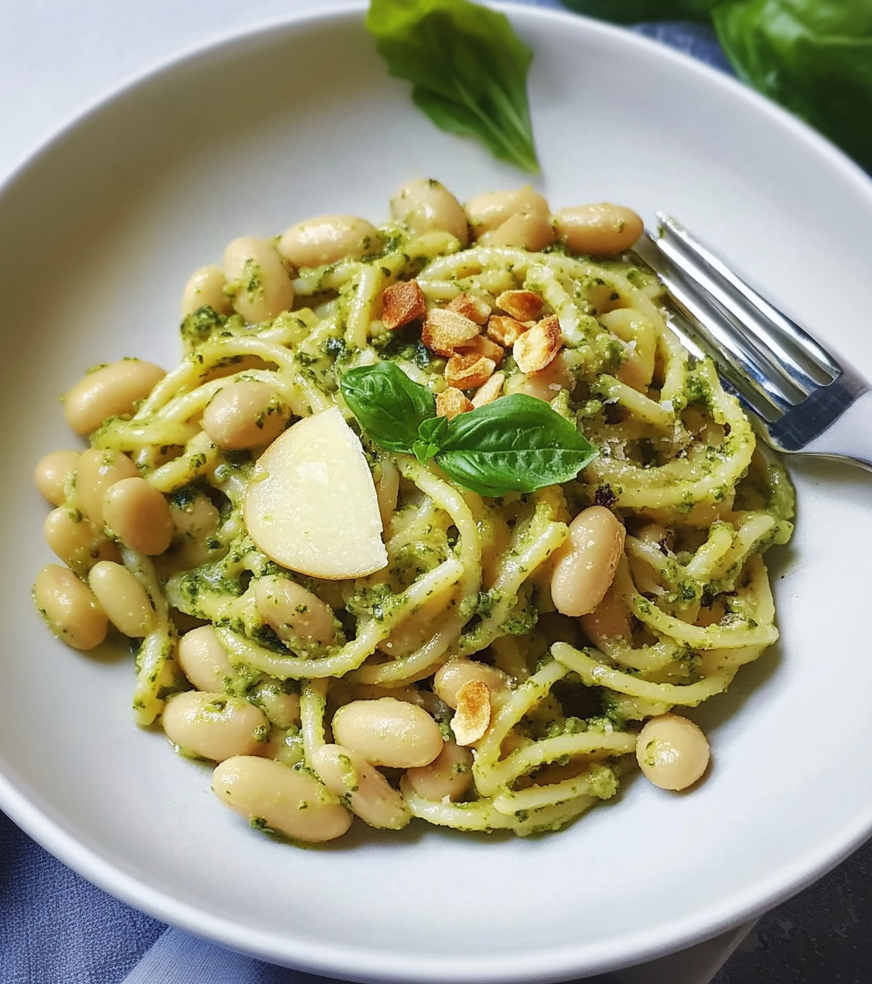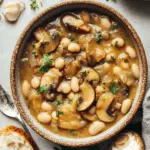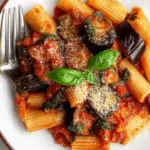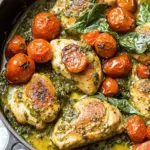This Pesto Pasta with White Beans recipe is a quick, vegetarian dinner that aligns with the Mediterranean diet. It’s ideal for busy weeknights, requiring minimal preparation and offering a satisfying, meatless meal.
Full Recipe:
Ingredients
- 12 oz pasta (e.g., orecchiette)
- 1 (14 oz) can cannellini beans, drained
- 1 cup pesto (homemade or store-bought)
Directions
- Bring a large pot of salted water to a boil.
- Add pasta and cook for 2 minutes less than the package instructions.
- Reserve 1 cup of pasta water, then drain the pasta.
- Return the pasta to the pot. Add ½ cup of the reserved water and the cannellini beans. Simmer for 2 minutes, stirring frequently.
- Remove from heat, add the pesto, and stir to create a creamy sauce. Add more reserved water if needed to reach desired consistency.
Nutritional Facts (per serving)
- Calories: 525 kcal
- Protein: 17 g
- Fat: 15 g
- Carbohydrates: 75 g
- Fiber: 8 g
- Sodium: 300 mg
The Appeal of Pesto Pasta with White Beans
What makes this recipe stand out is its simplicity and versatility. Pesto itself is a classic Italian sauce made primarily from fresh basil, garlic, pine nuts, Parmesan cheese, and olive oil. It’s known for its rich, aromatic flavor and vibrant green color. By pairing pesto with pasta and white beans, the dish becomes not only flavorful but also protein-packed and fiber-rich, thanks to the beans.
Cannellini beans, sometimes called white kidney beans, add a creamy texture and mild flavor that blends seamlessly with the pesto and pasta. They provide a plant-based protein source, making this meal suitable for vegetarians and a great option for those looking to reduce meat consumption without sacrificing nutrition or taste.
Health Benefits
This recipe offers numerous health benefits. Pesto is a nutrient-dense sauce, thanks largely to its core ingredients. Basil is rich in antioxidants and has anti-inflammatory properties. Garlic is known for its immune-boosting effects, while pine nuts provide healthy fats and essential minerals like magnesium and zinc.
Cannellini beans contribute a good amount of dietary fiber, which aids in digestion and helps maintain a feeling of fullness after meals. They also provide complex carbohydrates, essential for sustained energy release, and are a great source of plant-based protein. This makes the dish balanced in macronutrients, combining carbohydrates from the pasta, healthy fats from the pesto, and protein from the beans.
The olive oil used in pesto is rich in monounsaturated fats, which are heart-healthy and help reduce inflammation. Parmesan cheese adds calcium and protein but should be used in moderation due to its sodium content.
Suitability for Different Diets
Pesto Pasta with White Beans is highly adaptable for various dietary preferences. It’s naturally vegetarian and can be made vegan by substituting the Parmesan cheese with a plant-based alternative or nutritional yeast, which mimics the cheesy flavor. Gluten-free pasta options can easily be used for those with gluten sensitivities or celiac disease.
The dish fits well into Mediterranean and plant-forward diets, which emphasize whole foods, legumes, nuts, and healthy fats. It’s also great for meal prep as it reheats well and the flavors meld nicely over time.
Why This Recipe is Perfect for Busy Lifestyles
In today’s fast-paced world, many people seek meals that don’t require hours in the kitchen but still provide great flavor and nourishment. This pesto pasta recipe ticks those boxes perfectly. It requires minimal cooking time since the pasta cooks quickly and the pesto sauce is ready to use or can be whipped up in minutes if homemade.
Using canned cannellini beans saves prep time without compromising on nutrition, making this a convenient weeknight dinner. It’s a one-pot meal once you combine everything, which simplifies cleanup. This efficiency is especially valuable for individuals or families juggling work, school, and other activities.
Flavor Profile and Texture
The flavor profile of Pesto Pasta with White Beans is both fresh and savory. The basil pesto provides an herby, garlicky, and nutty taste that brightens the dish. The beans add a mild earthiness and creaminess that balances the sharpness of the pesto.
Texture-wise, the pasta offers the necessary chewiness, while the beans add a tender bite. The slight creaminess from the pesto coating the pasta and beans creates a luscious mouthfeel. Adding a bit of the reserved pasta water to the sauce helps it cling better to the pasta, enhancing every forkful.
Variations and Add-Ons
This dish is incredibly flexible and can be customized to suit different tastes and dietary needs. Some popular variations include:
-
Adding sautéed vegetables like cherry tomatoes, spinach, or zucchini for extra color, nutrients, and freshness.
-
Including grilled chicken or shrimp for added protein if you don’t mind meat.
-
Topping with toasted pine nuts or walnuts for a delightful crunch.
-
Incorporating a squeeze of fresh lemon juice or zest to brighten the flavors further.
-
Using different types of beans such as chickpeas or great northern beans as a substitute for cannellini.
These tweaks can keep the recipe exciting and allow it to fit various occasions, from casual dinners to small gatherings.
Cultural and Culinary Roots
Pesto originated in Genoa, the capital of Italy’s Liguria region, where it was traditionally made with basil, garlic, pine nuts, Parmesan, and olive oil. The word “pesto” comes from the Italian verb “pestare,” meaning “to pound” or “crush,” referencing the original method of making the sauce with a mortar and pestle.
Combining pesto with pasta is a time-honored tradition in Italian cuisine, celebrated for its fresh, vibrant taste. The addition of beans reflects a broader Mediterranean approach to cooking that values legumes as staple ingredients for their nutritional benefits and affordability.
Sustainability and Cost-Effectiveness
Using pantry staples like dried or canned beans and pasta makes this recipe budget-friendly and sustainable. Beans have a low environmental footprint compared to animal proteins, making this dish a more eco-conscious choice. Pesto, made primarily from basil and nuts, uses seasonal and plant-based ingredients that support sustainable eating habits.
Tips for the Best Results
-
Use high-quality pesto or make your own with fresh ingredients to ensure the best flavor.
-
Don’t overcook the pasta; slightly undercooked pasta will finish cooking when combined with the sauce, ensuring a perfect texture.
-
Save some pasta water when draining; the starch helps to emulsify the pesto sauce and bind it to the pasta.
-
Rinse canned beans to reduce sodium content unless using low-sodium varieties.
-
Serve immediately for the freshest taste, or refrigerate and gently reheat with a splash of water or olive oil.
Conclusion
Pesto Pasta with White Beans is a flavorful, nutritious, and easy-to-prepare dish that deserves a place in any home cook’s repertoire. Its combination of fresh pesto, hearty beans, and satisfying pasta offers a balanced meal rich in protein, fiber, and healthy fats. This recipe’s versatility and simplicity make it perfect for busy individuals looking for a wholesome vegetarian dinner that doesn’t skimp on taste.






